You have no items in your shopping cart.
You have no items to compare.
Welcome to Confidence USA Inc.
Epimedium
![]()
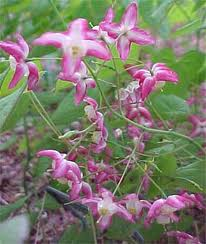
International Journal of Impotence Research (2006) 18, 335–342. doi:10.1038/sj.ijir.3901437; published online 5 January 2006
Epimedium brevicornum Maxim extract relaxes rabbit corpus cavernosum through multitargets on nitric oxide/cyclic guanosine monophosphate signaling pathway
J-H Chiu1,2,3, K-K Chen4,5, T-M Chien1, W-F Chiou6, C-C Chen6, J-Y Wang1, W-Y Lui2 and C-W Wu2
- Institute of Traditional Medicine, School of Medicine, National Yang-Ming University, Taipei, Taiwan, ROC
- Institute of Traditional Medicine, School of Medicine, National Yang-Ming University, Taipei, Taiwan, ROC
- Division of General Surgery, Veterans General Hospital, Taipei, Taiwan, ROC
- Cheng-Hsiung Rehabilitation Medical Center, Taipei, Taiwan, ROC
- Division of Urology, Department of Surgery, Veterans General Hospital, Taipei, Taiwan, ROC
- Department of Surgery, School of Medicine, National Yang-Ming University, Taipei, Taiwan, ROC
- National Research Institute of Chinese Medicine, Taipei, Taiwan, ROC
Correspondence: Dr J-H Chiu, Institute of Traditional Medicine, School of Medicine, National Yang-Ming University, 155, Sec. 2, Li-Nong St., Peitou, Taipei 112, Taiwan. E-mail: chiujh@mailsrv.ym.edu.tw
Received 28 September 2005; Revised 31 October 2005; Accepted 11 November 2005; Published online 5 January 2006.
Abstract
Epimedium brevicornum Maxim (EbM) has been reputed to have sexual stimulation effects on males. The study is aimed to test the hypothesis that EbM extracts relaxed the corpus cavernosum (CC) smooth muscle through activation of multitargets on nitric oxide (NO)/cyclic guanosine monophosphate (cGMP) signaling pathway. Water extract of EbM and its subfraction (EP-20) were prepared and standardized by high-performance liquid chromatography. Isolated rabbit CC strips were mounted in organ baths and isometric tension was recorded in the presence or absence of specific inhibitors related to NO/cGMP signaling such as L-NG-nitro-arginine methyl ester (L-NAME), 1H-[1,2,4]oxadiazolo-[4,3-a] quinoxalin-1-one (ODQ, a guanylyl cyclase inhibitor) or phosphodiesterase 5 (PDE 5) inhibitors. cGMP level was determined in EP-20-treated CC strips. The results showed that EP-20 enriched the content of L-arginine in the process of purification and relaxed the CC smooth muscle precontracted with phenylephrine (PE, 1 ![]() M) in a concentration-dependent manner. Besides, EP-20 increased the amount of cGMP production in rabbit CC tissues. Coincubation with EP-20 and L-NAME or ODQ significantly decreased EP-20-induced relaxation whereas EP-20 increased sodium nitroprusside-induced relaxation in PE-precontracted CC strips. Besides, EP-20 increased the potency and the duration of the relaxation effects caused by electrical field stimulation. Finally, EP-20 could potentiate PDE 5 inhibitors in relaxation of PE-precontracted CC strips. We concluded that extract of EbM relax the CC smooth muscle through multitargets in NO/cGMP/PDE 5 pathway and might bring into perspective the treatment strategy for those patients with erectile dysfunction.
M) in a concentration-dependent manner. Besides, EP-20 increased the amount of cGMP production in rabbit CC tissues. Coincubation with EP-20 and L-NAME or ODQ significantly decreased EP-20-induced relaxation whereas EP-20 increased sodium nitroprusside-induced relaxation in PE-precontracted CC strips. Besides, EP-20 increased the potency and the duration of the relaxation effects caused by electrical field stimulation. Finally, EP-20 could potentiate PDE 5 inhibitors in relaxation of PE-precontracted CC strips. We concluded that extract of EbM relax the CC smooth muscle through multitargets in NO/cGMP/PDE 5 pathway and might bring into perspective the treatment strategy for those patients with erectile dysfunction.
Keywords: erectile dysfunction, Epimedium brevicornum, organ bath, cGMP, PDE 5
Introduction
Sexual dysfunction remains a major problem in the fifth decade of male life and continues to increase in prevalence with each subsequent decade. The ability to have erections is reliant on the complex interaction among neurological, psychological and vascular responses.1, 2 There is consensus that sildenalfil, tadalafil and vardenafil are promising oral agents for the treatment of patients with erectile dysfunction (ED). Many effects such as facial flushing, dizziness, blue vision and headache have been described, although the rate of interruption of such treatment is low.3, 4, 5
Over the past decade, the number of people in the United States who report using alternative therapies has increased to over 40%.6, 7, 8 However, more evidence is needed to make such therapies an evidence-based medicine. Epimedium brevicornum Maxim (EbM) or Yin-Yang-Huo, an Epimedium spp, has been reported to have anti-inflammatory and antitussive effect and recent pharmacological studies have demonstrated that it increases the coronary flow by reducing vascular resistance and lowers the blood pressure.9, 10 Interestingly, EbM has been reputed in many old traditional literatures to have a sexual stimulatory effect on males. However, pro-erectile effects of EbM and its mechanisms of action remain far less understood. Our recent studies suggested that EbM increased intracavernous pressure (ICP) in rat model (KK Chen, manuscript in preparation). Therefore, the aim of this study is to investigate the effect of EbM extract elicitation of penile erection and its mechanisms related to nitric oxide (NO)/cyclic guanosine monophosphate (cGMP) signaling pathway.
Materials and methods
Chemicals and reagents
The well-known pure compounds extracted from EbM are the glycosides icariin and noricariin.11, 12 Icariin (molecular weight=626.65 Da) as an internal standard was purchased from Nacalai Tesque (Kyoto, Japan). Chromatographic grade acetonitrile and monosodium phosphoric acid were obtained from E. Merck (Darmstadt, Germany). Triply de-ionized water from Millipore (Bedford, MA, USA) was used for all preparations.
Preparation of EbM extracts
EbM was purchased from a local wholesale distributor (Taipei, Taiwan, Republic of China). The EbM extracts were prepared as follows. EbM (300 gm) was extracted with 1 l water (water-soluble fraction, denoted as EPW), which were further purified until the total volume down to 100 ml. The extracts were filtered through layers of gauze, the residues discarded and the filtrates were kept at -20°C, followed by lyophilizing the samples. The final powder weight was 4.53 g. For further purification, EPW was subfractioned into EP-0, EP-20, EP-50, EP-100 by elution of 0, 20, 50 and 100% methanol through Diaion HP20 column, respectively. Then, the EP-20 extract was chromatographed on a column of Cosmosil® 5-C18-AR II and eluted with a gradient of water-acetonitrite (9:1 to acetonitrite alone), to yield six fractions (EP-20-1 to EP-20-6) by time interval. Each extracts was tested on phenylephrine (PE)-contracted corpus cavernosum (CC) strips for their relaxation potencies.
Liquid chromatography
The high performance liquid chromatography (HPLC) system consisted of a chromatographic pump (PM-80, Bioanalytical System, West Lafayette, IN, USA), an injector (Rheodyne 7125, Cotati, CA, USA) equipped with a sample loop and an ultraviolet detector (Varian, Walnut Creek, CA, USA). EbM extracts and its major ingredient were separated using an Alltima reversed phase C18 column (250 ![]() 4.6 mm I.D.; particle size 5 m; Deerfield, IL, USA) preserved at an ambient temperature to perform the ideal chromatographic phase. The conditions of mobile phase were selected. The mobile phase was filtered through a millipore 0.45
4.6 mm I.D.; particle size 5 m; Deerfield, IL, USA) preserved at an ambient temperature to perform the ideal chromatographic phase. The conditions of mobile phase were selected. The mobile phase was filtered through a millipore 0.45 ![]() m filter and degassed before use. The UV wavelength was set at 203 nm for the determination of EbM. Output data from the detector were integrated via an EZChrom chromatographic data system (Scientific Software, San Ramon, CA, USA). Several steps for quality experiments including retention time, spiking of authentic standard, change of wavelength and change of the composition of mobile phase were used to examine the contents in EbM extracts.13 To standardize and quantify the EbM extracts, icariin (C33H40O15, molecular weight: 676.65 Da) was used as an internal standard with a chromatograph column (Acq-Tac, Waters, Kyoto, Japan) and a UV detector (G1314A, Agilent, Waldbronn, Germany).11, 12 Furthermore, the L-arginine level was determined and quantified by HPLC analysis with a chromatograph column (38023-11, Cosmosil, Kyoto, Japan) as described previously.14 In brief, 10 mg L-arginine (A5006, Sigma, ST Louis, USA) was dissolved in 0.1 M HCl as stock solution. Serial concentrations of L-arginine (0.00625, 0.0125, 0.025, 0.05 and 0.1 mg/ml) were used to get a linear standard culver, followed by determination the L-arginine level in EbM extracts with a fluorescence detector. The coefficient variance between inter-day and intra-day was less than 5%.
m filter and degassed before use. The UV wavelength was set at 203 nm for the determination of EbM. Output data from the detector were integrated via an EZChrom chromatographic data system (Scientific Software, San Ramon, CA, USA). Several steps for quality experiments including retention time, spiking of authentic standard, change of wavelength and change of the composition of mobile phase were used to examine the contents in EbM extracts.13 To standardize and quantify the EbM extracts, icariin (C33H40O15, molecular weight: 676.65 Da) was used as an internal standard with a chromatograph column (Acq-Tac, Waters, Kyoto, Japan) and a UV detector (G1314A, Agilent, Waldbronn, Germany).11, 12 Furthermore, the L-arginine level was determined and quantified by HPLC analysis with a chromatograph column (38023-11, Cosmosil, Kyoto, Japan) as described previously.14 In brief, 10 mg L-arginine (A5006, Sigma, ST Louis, USA) was dissolved in 0.1 M HCl as stock solution. Serial concentrations of L-arginine (0.00625, 0.0125, 0.025, 0.05 and 0.1 mg/ml) were used to get a linear standard culver, followed by determination the L-arginine level in EbM extracts with a fluorescence detector. The coefficient variance between inter-day and intra-day was less than 5%.
Isolation of rabbit CC
Male New Zealand rabbits weighting 2.5–3 kg were treated under the regulations of the 'Principles of laboratory animal care' (NIH publication No. 86–23, revised 1985). After overnight fasting with free access to water, rabbits were anesthetized and killed with overdoses of intramuscular injection of ketamine hydrochloride (50 mg/kg) and xylazine (5 mg/kg). The organ bath for rabbit CC strips was prepared with some modification as described previously.15 In brief, the entire penile tissue was transected from the base, quickly rinsed and kept immersed in oxygenated Krebs' physiological solution at 37°C. The composition of Krebs' solution was the following (in mM): 115.0 NaCl, 5.0 KCl, 2.5 CaCl2, 1.2 MgSO4, 1.2 NaH2PO4, 25.0 NaHCO3, and 11.0 glucose; pH, 7.3![]() 7.4. The layer of tunica albuginea was removed by sharp dissection under a microscope. Removal of the adjacent soft tissue around the CC and proper care was taken to avoid disrupting the continuity and integrity of the CC strips.
7.4. The layer of tunica albuginea was removed by sharp dissection under a microscope. Removal of the adjacent soft tissue around the CC and proper care was taken to avoid disrupting the continuity and integrity of the CC strips.
Recording of isometric tension
The CC strips were transferred to jacketed 10-ml tissue baths filled with Krebs' solution maintained at 37°C and equilibrated with 95% O2–5% CO2. The strips were anchored to the bottom of the bath at one end and to the isometric muscle transducers (model FTO3; Grass Instruments Co., Quincy, MA, USA) at the other. The isometric muscle transducer in turn was connected to a polygraph recorder (Gould TA240, Ohio, USA). All data were recorded and stored in a computer equipped with an offline analysis software (AcqKnowledge III-MP 100 WSW, Biopac System, Inc., Santa Barbara, CA, USA). The recording channels were calibrated at 1 gm/cm in the beginning and were left undisturbed for the rest of the experiment. After mounting the tissue, the smooth muscle strips were stretched to a resting tension equivalent to 1.5 g force and equilibrated for 60–90 min.
Relaxation effect of CC
For the evaluation of relaxation, the CC strips were first contracted with PE (1 ![]() M) and responses were examined using cumulative concentration–response curve (CRC) by increasing the concentration of agents after a steady response to the previous administration had been reached. The relaxation responses of CC strips were validated by cumulative doses of sodium nitroprusside (SNP). After confirming the model validity, the responses of EbM extracts or its vehicle were obtained by adding agents cumulatively to the organ bath. Construction of CRCs was based on degrees of relaxation of the PE-induced contractions. A preliminary study had shown no significant differences between results obtained with single or multiple exposures to increasing concentrations of EbM extracts (i.e. no tachyphylaxis, desensitization or tissue fatigue was observed).
M) and responses were examined using cumulative concentration–response curve (CRC) by increasing the concentration of agents after a steady response to the previous administration had been reached. The relaxation responses of CC strips were validated by cumulative doses of sodium nitroprusside (SNP). After confirming the model validity, the responses of EbM extracts or its vehicle were obtained by adding agents cumulatively to the organ bath. Construction of CRCs was based on degrees of relaxation of the PE-induced contractions. A preliminary study had shown no significant differences between results obtained with single or multiple exposures to increasing concentrations of EbM extracts (i.e. no tachyphylaxis, desensitization or tissue fatigue was observed).
Effects of inhibitors were studied by preincubation with the inhibitor for 20 min, then contraction was induced by PE, after that the relaxation profile of EbM extracts were observed. To identify the involvement of NO/cGMP pathway in the relaxation actions of EbM extracts, the CC strips were incubated with a potent NO syntheses inhibitor, L-NG-nitro-arginine methyl ester (L-NAME 3 ![]() 10-4 M) or 1H-[1,2,4]oxadiazolo-[4,3-a] quinoxalin-1-one (ODQ, 3
10-4 M) or 1H-[1,2,4]oxadiazolo-[4,3-a] quinoxalin-1-one (ODQ, 3 ![]() 10-5 M, a guanylyl cyclase inhibitor) for 10 min, respectively, before the construction of post-inhibitor treatment cumulative CRCs of EbM extracts and observed for any changes in potency.
10-5 M, a guanylyl cyclase inhibitor) for 10 min, respectively, before the construction of post-inhibitor treatment cumulative CRCs of EbM extracts and observed for any changes in potency.
Determination of cGMP level in rabbit CC strips
The CC strips were pretreated with EP-20 in the presence or absence of ODQ (3 ![]() 10-5 M) or SNP (1
10-5 M) or SNP (1 ![]() 10-6 M) or phosphodiesterase 5 (PDE 5) inhibitor (sildenafil, 1
10-6 M) or phosphodiesterase 5 (PDE 5) inhibitor (sildenafil, 1 ![]() 10-7 M) for 20 min, followed by freezing the CC strips into liquid nitrogen. Then, a 0.2 g frozen tissue was homogenized with 1 ml 5% trichloroacetic acid (w/v), followed by determination of cGMP levels by commercially available EIA kits.16
10-7 M) for 20 min, followed by freezing the CC strips into liquid nitrogen. Then, a 0.2 g frozen tissue was homogenized with 1 ml 5% trichloroacetic acid (w/v), followed by determination of cGMP levels by commercially available EIA kits.16
Statistics
All the changes in CC strips tension in response to drugs are expressed on percentile basis and all the values are expressed as mean![]() s.e.m. The relaxant responses are normalized as the percentage of relaxation of the contraction originally induced by PE. Statistic evaluation of the data was performed by one-way analysis of variance (ANOVA) or general linear models procedure (two-way ANOVA) followed by post hoc Dunnet's test (SPSS 12.0.1 for windows, Release 12.0.1, SPSS Inc., Chicago, IL, USA). For non-parametric analysis, Wilcoxan's rank sum test was used.P<0.05 was considered statistically significant.
s.e.m. The relaxant responses are normalized as the percentage of relaxation of the contraction originally induced by PE. Statistic evaluation of the data was performed by one-way analysis of variance (ANOVA) or general linear models procedure (two-way ANOVA) followed by post hoc Dunnet's test (SPSS 12.0.1 for windows, Release 12.0.1, SPSS Inc., Chicago, IL, USA). For non-parametric analysis, Wilcoxan's rank sum test was used.P<0.05 was considered statistically significant.
Results
Purification of EPW and EP-20 from EbM
EbM was partially purified and analyzed with autoscaled HPLC. Icariin (molecular weight: 676.65 Da) was used for quantification of the purity of extracts. When detected by a wavelength of 270 nm, the retention time of icariin was 36.628 min. Naphthalene was used as internal standard. The icariin content in EPW was 1.17% whereas undectable in EP-20.
The bioactivity of the water crude extract (EPW) and further extract EP-20 was tested for the relaxation effect in CC strips precontracted with 1 ![]() M PE. The results showed that both EPW and EP-20 relaxed the PE-precontracted CC strips in a concentration-dependent manner. (Figure 1a). The 50% relaxation concentration of EPW and 25% of EP-20 were 65 and 208
M PE. The results showed that both EPW and EP-20 relaxed the PE-precontracted CC strips in a concentration-dependent manner. (Figure 1a). The 50% relaxation concentration of EPW and 25% of EP-20 were 65 and 208 ![]() g/ml, respectively. However, further six purified extracts from EP-20, namely, EP-20-1 to EP-20-6, presented little relaxation effect as did the extracts of EPW or EP-20 (Figure 1b).
g/ml, respectively. However, further six purified extracts from EP-20, namely, EP-20-1 to EP-20-6, presented little relaxation effect as did the extracts of EPW or EP-20 (Figure 1b).
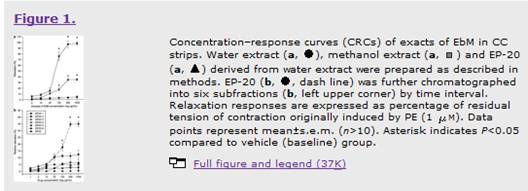
The involvement of NO/cGMP pathway in EP-20-induced relaxation effect
After co-incubation with L-NAME (3 x 10-4 M), the EP-20-induced relaxation effects were partially blocked by 30% in PE-precontracted CC strips (Figure 2a), Whereas in co-incubation with a guanlyl cyclase inhibitor (ODQ, 3 x 10-5 M), the relaxation effects were also partially blocked (Figure 2b).
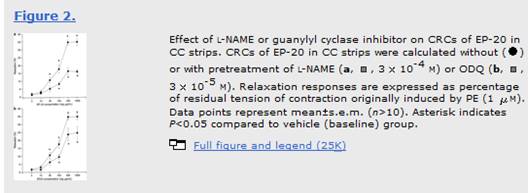
EP-20 enhanced relaxation effect with SNP in rabbit CC strips
In Figure 3, EP-20 (0.01 mg/ml) was pretreated in PE-precontracted CC strips for 10 min, followed by incubation with different concentration of NO donor (SNP). In contrast, SNP (0.01 mg/ml) was pretreated in PE-precontracted CC strips for 10 min, followed by incubation with different concentration of EP-20. The results showed that there was a shift to left of the constructed CRC in EP-20 as compared to SNP alone (Figure 3a) and vice versa (Figure 3b). The data suggested that EP-20 enhanced relaxation effect with SNP in rabbit CC strips.
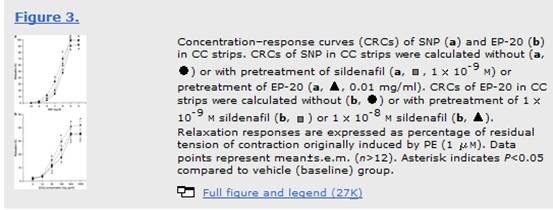
EP-20 increased cGMP level in EP-20 treated CC strips
In biochemical studies, the CC strips were pretreated with EP-20 in the presence or absence of ODQ or PDE 5 inhibitor for 20 min, followed by determination the cGMP level in CC tissues The results showed that there was a significantly increased cGMP level in EP-20-treated (0.1 and 0.3 mg/ml) CC tissues (Figure 4). Taken together, the results suggested that EP-20 induced relaxation of rabbits CC smooth muscle tissue through not only the increase of cGMP production but also the enhancement of SNP effect.

EP-20 increases the potency and the duration of the relaxation effects caused by electrical field stimulation
When the rabbit CC strips precontracted with PE were subjected to electrical field stimulation (EFS), PE-20 (0.1, 0.3 mg/ml) significantly increased EFS-induced relaxation at a frequency of 4 and 8 Hz (Figure 5a). However, only PE-20 at a concentration of 0.3 mg/ml increased the duration of EFS-induced relaxation in PE-precontracted CC strips (Figure 5b).
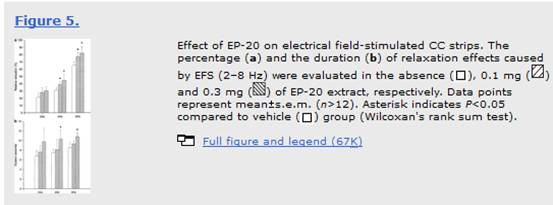
Combination effect of EP-20 and PDE 5 inhibitors
To investigate the potential role of EP-20 on perspective clinical application, low concentration EP-20 (0.1 mg/ml) was co-incubated with PED 5 inhibitors (1 ![]() 10-9 M) on PE-precontracted CC strips. The percentage of relaxation in sildenafil, vardenafil and tadalafil alone group was 23.7
10-9 M) on PE-precontracted CC strips. The percentage of relaxation in sildenafil, vardenafil and tadalafil alone group was 23.7![]() 4.8, 26.0
4.8, 26.0![]() 4.9 and 16.1
4.9 and 16.1![]() 6.6%, respectively; whereas that of each combination groups was 36.2
6.6%, respectively; whereas that of each combination groups was 36.2![]() 4.9, 40.7
4.9, 40.7![]() 3.4 and 34.2
3.4 and 34.2![]() 2.7%, respectively (Figure 6a). When in combination with ineffective concentration of EP-20 (0.01 mg/ml), the percentage of relaxation in sildenafil, vardenafil and tadalafil combination group was 32.4
2.7%, respectively (Figure 6a). When in combination with ineffective concentration of EP-20 (0.01 mg/ml), the percentage of relaxation in sildenafil, vardenafil and tadalafil combination group was 32.4![]() 2.6, 35.2
2.6, 35.2![]() 2.9 and 22.3
2.9 and 22.3![]() 3.7%, respectively (Figure 6b). The results suggested that there was a potentiate but not additive nor synergic effect for EP-20 in combination with the present PED 5 inhibitors.
3.7%, respectively (Figure 6b). The results suggested that there was a potentiate but not additive nor synergic effect for EP-20 in combination with the present PED 5 inhibitors.
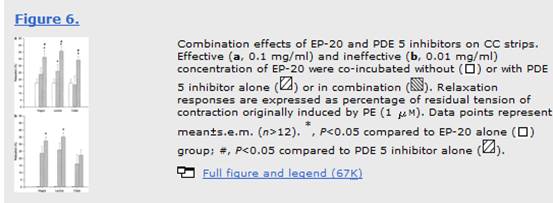
L-arginine level detected in EPW and EP-20
In order to identify whether L-arginine, an NO precursor, could be detected in EbM extracts, HPLC identification and quantification was performed and the results showed there was an enrichment of L-arginine in EP-20 (0.1148%) as compared to its previous extract or EPW (0.058%).
Discussion
In this study, we have clearly demonstrated that EbM extract causes concentration-dependent relaxation of isolated rabbit CC smooth muscle through multitargets related to L-arginine/NO/cGMP pathway. To our knowledge, this is the first study to provide evidence concerning the herbal extracts on PDE 5 inhibitors for proerectile functions. In fact, the fact that EbM extract potentiates the commonly used PDE 5 inhibitors, such as sildenafil and vardenafil, provides a new treatment strategy for those patients with ED.
There are many studies using rats as in vivo model to investigate drug effects on penile tissue.17, 18, 19 Our recent works found that direct injection of water extract of EbM (EPW) at a dose 300 ![]() g to 10 mg into rats penis significantly increased the ICP (Chen, manuscript submitted). As it was difficult to use rat CC strips in organ bath for mechanism studies, rabbit's CC strips were commonly used as described previously.15, 20, 21, 22
g to 10 mg into rats penis significantly increased the ICP (Chen, manuscript submitted). As it was difficult to use rat CC strips in organ bath for mechanism studies, rabbit's CC strips were commonly used as described previously.15, 20, 21, 22
It has been reported that nonginkgolide nonflavonoid fraction of ginkgo biloba extract (NGE) has the most potent relaxing effect on vascular smooth muscle. In the tissue precontracted by norepinephrine (10-5 M), corpus cavernosal tissue of human and rabbit showed relaxation in response to subfractions of NGF in a dose-dependent manner.23 In this study, the involvement of cAMP and potassium channel opening might contribute to the relaxing effect, which is quite different from our present findings. Icariin is a pure compound isolated from Epimedium species,11 and the most abundant compound in EbM extract (fraction at 33.432 in Figure 1) is 2-O-rhamnosylicariside. It is unlikely that icariin or 2-O-rhamnosylicariside play important roles in relaxation of CC smooth muscle strips, as these two compounds do not cause relaxation activities in rabbit CC organ bath (data not shown). Furthermore, it is of note that crude extracts of EbM (EPW and EP-20) concentration- dependently relax the PE-contracted CC strips. However, further purified extracts, namely, EP-20-1 to EP-20-6, presented little relaxation effect. The order of extracts potency (EPW>EP-20>EP-20-1 to EP-20-6) indicates that the bioactivity is getting lost during the process of purification. Three possibilities concerning the potency of crude extract being stronger than that of pure compounds have been proposed. Firstly, the activity of pure compound is not prominent as that of crude extract. Secondly, there are some active factors other than well-known pure compounds in the crude extract. Thirdly, synergic or potentiated effects between many compounds are present in the extract. The discrepancy between biological responses to crude extracts and pure compounds are commonly observed in many herbal remedies on clinical aspect, for which more evidence is needed to prove or disprove it.
Phosphodiesterases (PDE) are key enzymes in the regulation of CC smooth muscle tone. Recently, many specific PDE 5 inhibitors have been introduced in clinical studies. Owing to the fact that therapeutic doses of PDE 5 inhibitors exhibit slight blood-pressure-lowering effects, the combination of PDE 5 inhibitors with any NO donor is absolutely contraindicated because of potentially life-threatening hypotension.3, 4, 5 Therefore, it is important to search for drugs that could be used in combination with PDE 5 inhibitors so that the side effects derived from the latter could be reduced. The pharmacology of the counteractive drugs has been investigated clinically and a combination of 50 mg sildenafil with 5 mg dihydro-ergotamine has been prescribed under the therapeutic concept to increase blood influx and or to decrease blood efflux in patients with ED.24 Accordingly, it is reasonable to investigate multitargets treatment strategy on L-arginine/NO/cGMP signaling pathway. In our study, we found the increased L-arginine level at least plays a non-negligible role for the action of EP-20, even though there was no functional evidence demonstrated.
Recently, it is interesting to find that the vasodilating effect of wine-derived phenolic compounds is associated with the inhibition of PDEs and, in particular, PDE 5. These results indicate that polyphenols-induced vasorelaxation may also be sustained by smooth muscle PDE inhibition by anthocyanins present in red wines and grapes.25 In our studies, we have demonstrated three mechanisms of action on EbM-induced relaxation of rabbit CC strips, namely, (1) enriched L-arginine level; (2) increased cGMP production; and (3) enhanced SNP effect. Moreover, the EbM extract can potentiate the relaxation effects induced by PDE 5 inhibitors such as sildenafil and vardenafil.
In conclusion, we found that extracts of EbM relax the CC smooth muscle through multitargets in NO/cGMP/PDE 5 pathway and might bring into perspective the treatment strategy for those patients with ED.
References
- Nehra A, Moreland RB. Neurologic erectile dysfunction. Urol Clin North Am 2001; 28: 289–308. | Article | PubMed | ISI | ChemPort |
- Mills TM. Vasoconstriction and vasodilation in erectile physiology. Curr Urol Rep 2002; 3: 477–483. | PubMed |
- Goldstein I, Lue TF, Padma-Nathan H, Rosen RC, Steers WD, Wicker PA. Oral sildenafil in the treatment of erectile dysfunction. N Eng J Med 1998; 338: 1397–1404. | Article | ISI | ChemPort |
- Chen KK, Hsieh JT, Huang ST, Jiaan DB, Lin JS, Wang CJ. ASSESS-3: a randomised, double-blind, flexible-dose clinical trial of the efficacy and safety of oral sildenafil in the treatment of men with erectile dysfunction in Taiwan. Int J Imptot Res 2001; 13: 221–229. | Article | ChemPort |
- Hellstrom WJ, Gittelman M, Karlin G, Segerson T, Thibonnier M, Taylor T et al. Vardenafil for treatment of men with erectile dysfunction: efficacy and safety in a randomized, double-blind, placebo-controlled trial. J Androl 2002; 23: 763–771. | PubMed | ISI | ChemPort |
- Eisenberg DM, Davis RB, Ettner SL, Appel S, Wilkey S, Van Rompay M et al. Trends in alternative medicine use in the United States, 1990–1997: results of a follow-up national survey. JAMA 1998; 280: 1569–1575. | Article | PubMed | ISI | ChemPort |
- Eisenberg DM, Cohen MH, Hrbek A, Grayzel J, Van Rompay MI, Cooper RA. Credentialing complementary and alternative medical providers. Ann Int Med 2002; 137: 965–973. | PubMed | ISI |
- Normile D. The new face of traditional Chinese medicine. Science 2003; 299: 188–190. | Article | PubMed | ISI | ChemPort |
- Wu H, Lien EJ, Lien LL. Chemical and pharmacological investigations of Epimedium species: a survey. Prog Drug Res 2003; 60: 1–57. | PubMed | ChemPort |
- Ye LC, Chen JM. Advances in study on pharmacological effects of Epimedium. Zhongguo Zhong Yao Za Zh 2001; 26: 293–295. | ChemPort |
- Chai Y, Ji S, Zhang G, Wu Y, Yin X, Liang D et al. Determination of icariin in Chinese traditional medicine by capillary zone electrophoresis. Biomed Chromatogr 1999; 13: 373–375. | Article | PubMed | ISI | ChemPort |
- Du Q, Xia M, Ito Y. Purification of icariin from the extract of Epimedium segittatum using high-speed counter-current chromatography. J Chromatogr A 2002; 962: 239–241. | Article | PubMed | ISI | ChemPort |
- Tsai TH. Assaying protein unbound drugs using microdialysis techniques [Review]. J Chromatogr B 2003; 797: 161–173. | Article | ISI | ChemPort |
- Cohen SA, De Antonis KM. Applications of amino acid derivatization with 6-aminoquinolyl-N-hydroxysuccinimidyl carbamate. Analysis of feed grains, intravenous solutions and glycoproteins. J Chromatogr A 1994; 661: 25–34. | Article | PubMed | ISI | ChemPort |
- Chiou WF, Chen CF. Pharmacological profile of evodiamine in isolated rabbit corpus cavernosum. Eur J Pharmacol 2002; 446: 151–159. | Article | PubMed | ISI | ChemPort |
- Huang YT, Lo JW, Lin HC, Tsai YT, Hong CY, Yang CM. Change in vascular cAMP and cGMP contents in portal hypertensive rats. Pharmacology 1995; 50: 86–91. | PubMed | ISI | ChemPort |
- Bennett NE, Kim JH, Wolfe DP, Sasaki K, Yoshimura N, Goins WF et al. Improvement in erectile dysfunction after neurotrophic factor gene therapy in diabetic rats. J Urol 2005; 173: 1820–1824. | Article | PubMed | ISI | ChemPort |
- Chen KK, Chan JY, Chang LS, Chen MT, Chan SH. Elicitation of penile erection following activation of the hippocampal formation in the rat. Neurosci Let 1992; 141: 218–222. | Article | ISI | ChemPort |
- Christ GJ, Day N, Santizo C, Sato Y, Zhao W, Sclafani T et al. Intracorporal injection of hSlo cDNA restores erectile capacity in STZ-diabetic F-344 rats in vivo. Am J Physiol Heart Circ Physiol 2004; 287: H1544–H1553. | Article | PubMed | ISI | ChemPort |
- Lau DH, Kommu S. Relaxation effects of adrenomedullin in isolated rabbit corpus cavernosum smooth muscle. BJU Int 2004; 94: 446–447. | Article | PubMed | ISI |
- Muneer A, Cellek S, Dogan A, Kell PD, Ralph DJ, Minhas S. Investigation of cavernosal smooth muscle dysfunction in low flow priapism using an in vitro model. Int J Impot Res 2005; 17: 10–18. | Article | PubMed | ISI | ChemPort |
- Shukla N, Jones R, Persad R, Angelini GD, Jeremy JY. Effect of sildenafil citrate and a nitric oxide donating sildenafil derivative, NCX 911, on cavernosal relaxation and superoxide formation in hypercholesterolaemic rabbits. Eur J Pharmacol 2005; 11: 224–231. | Article | ChemPort |
- Paick JS, Lee JH. An experimental study of the effect of ginkgo biloba extract on the human and rabbit corpus cavernosum tissue. J Urol 1996; 156: 1876–1880. | Article | PubMed | ISI | ChemPort |
- Dunzendorfer U, Behm A, Dunzendorfer E, Dunzendorfer A. Drug combinations in the therapy of low response to phosphodiesterase 5 inhibitors in patients with erectile dysfunction. In vivo 2002; 16: 345–348. | PubMed | ISI | ChemPort |
- Dell'Agli M, Galli GV, Vrhovsek U, Mattivi F, Bosisio E. In vitro inhibition of human cGMP-specific phosphodiesterase-5 by polyphenols from red grapes. J Agric Food Chem 2005; 23: 1960–1965. | Article | ChemPort |
Acknowledgements
This work was supported by a grant from Veterans General Hospital, Taipei (VGH93-349 and VGH94-362-3).
Disclaimer: This scientific independent research is for informational use only. The authors of the research are not affiliated with the Confidence USA, Inc and do not endorse the information. Likewise, the Confidence USA, Inc does not recommend or endorse any specific products related to the research.
I accept these terms





